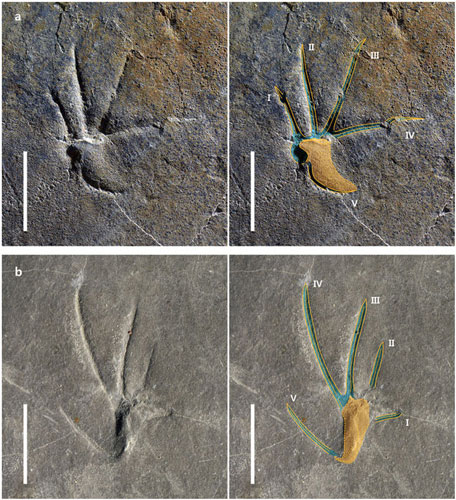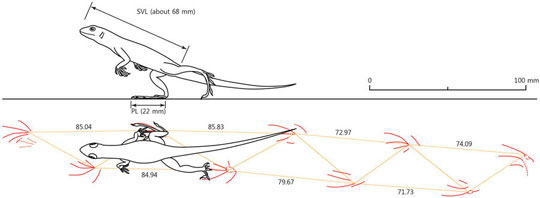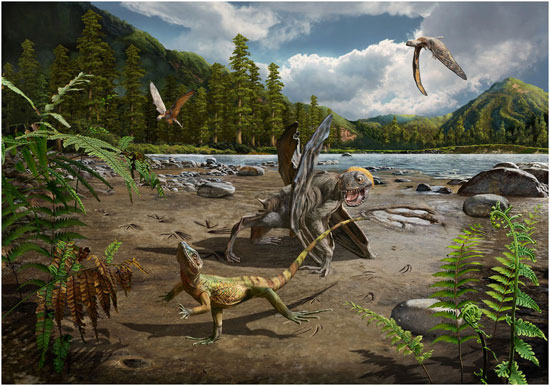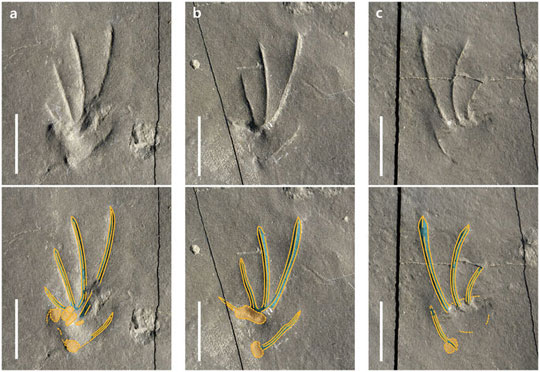Lizards Sprinted to Safety to Avoid Predation
A team of international scientists writing in the journal “Scientific Reports”, have described the oldest lizard trackways known to science that record bipedal behaviour. The little lizards lived around 110 million years ago, in what is now South Korea, it has been speculated that just like extant lizards, they took to their hind legs to avoid being eaten.
Lizard Trackways
The mudstone slab preserves a total of twenty-nine prints, representing four trackways made by lizards. The lizard trackways occur in the same horizon as the pterosaur ichnotaxon, Pteraichnus koreanensis, it has been speculated that these small animals were taking to their hind legs and sprinting away to avoid the attention of marauding flying reptiles.
A Lizard Escapes from a Pterosaur (Early Cretaceous of South Korea)
Picture credit: Zhao Chuang
Rare Lizard Trace Fossils from the Hasandong Formation
The researchers from the Chinese Academy of Sciences, Seoul National University, the Korea Institute of Geoscience and Mineral Resources along with Anthony Fiorillo of the Perot Museum of Nature and Science (Dallas, Texas) studied the mudstone slab, which measures approximately seventy centimetres by thirty centimetres in size and identified the tiny tracks, as that of a basal member of the Iguania Infraorder of lizards.
The team came to this conclusion as living iguanians, such as those in the Basiliscus genus (basilisk lizards), have strong hind legs and are facultative bipeds, that is, capable of running on their back legs when the need arises. The fossil record also shows that these types of lizards were present in Asia during the Early Cretaceous.
The Mudstone Slab with Trace Fossils and Accompanying Line Drawing
Picture credit: Scientific Reports
The trace fossils were excavated from an old quarry adjacent to Hadong power station in Hadong County, in south-central South Korea. It is believed that the strata in this area (Hasandong Formation) was laid down around 112 to 110 million years ago (Aptian/Albian faunal stages of the Early Cretaceous). The well-preserved lizard trackways have allowed the scientists to examine in detail the hand (manus) and foot (pes) anatomy of the ancient lizard.
When Did Lizards Develop Bipedal Capabilities?
Although, bipedal locomotion is known today and the Squamata (lizards and snakes), are the most specious of all the living reptile types, the fossil record for these creatures is particularly sparse. Palaeontologists, remain uncertain as to when bipedal locomotion in lizards arose, although it has been inferred based on the relative proportions of front and hind limbs as seen in Tijubina pontei, an Early Cretaceous lizard, whose fossils are associated with the Crato Formation of Brazil.
The lizard trackways discovered in South Korea suggest that bipedal locomotion in ancient lizards is deeply rooted in the phylogeny of lizard evolution.
Hand and Foot Tracks (Manus and Pes)

Picture credit: Scientific Reports
Sauripes hadongensis
The foot prints (pes) are plantigrade, indicating that this lizard walked on its toes and heels, just like us and all lizards today, as opposed to the digitigrade locomotion of the Dinosauria. Although the individual prints are very small, around two centimetres in length, the five toes (pentadactyl), are clearly defined.
The lizard tracks appear in the same horizon as the pterosaur ichnotaxon Pteraichnus koreanensis and it has been speculated that the lizards could have been escaping from a flying reptile. Behaving as a facultative biped, would also have elevated the head and this would have permitted the lizards to keep a better look out for aerial predators.
The scientists have estimated the ancient lizard’s body length by comparing the trackways to the extant lizard Tropidurus torquatus, a living member of the Infraorder Iguania. The ichnotaxon has been named Sauripes hadongensis which translates as “lizard foot from Hadong County”.
An Illustration of the Bipedal Locomotion of the Ancient Lizard

Picture credit: Scientific Reports
The Palaeoenvironment of Lower Cretaceous South Korea
The mudstone strata has produced tridactyl (three-toed) dinosaur tracks as well as trace fossils representing the tracks of small pterosaurs. Fossilised plants are also associated with these layers of rock. It is suggested that the mudstone represents deposits from a swampy area or possibly the margins of a lake.
The Hasandong Formation has yielded numerous body fossils including several different types of vertebrate (turtles, pterosaurs, crocodilians and dinosaurs). These fossilised bones are isolated, broken and highly fragmentary, indicating that they may have been exposed on the surface for some considerable time prior to subsequent burial. They also may have been transported for some distance before deposition. This taphonomy suggests that large rivers crossed this location, the mudstone slab may have been sited in an area away from a main river channel, that was subjected to periodic flooding by water with low energy, otherwise the delicate prints may not have been preserved.
Photographs of Individual Hind Foot Prints (Pes) with Digits Highlighted
Picture credit: Scientific Reports
To read Everything Dinosaur’s 2014 article about the discovery of a tiny Theropod dinosaur from South Korea: Tiny Terror from South Korea.
The scientific paper: “Lizards Ran Bipedally 110 Million Years Ago” by Hang-Jae Lee, Yuong-Nam Lee, Anthony R. Fiorillo and Junchang Lü published in Scientific Reports.
Visit the Everything Dinosaur website: Everything Dinosaur.









Leave A Comment